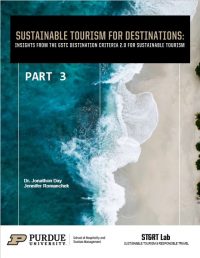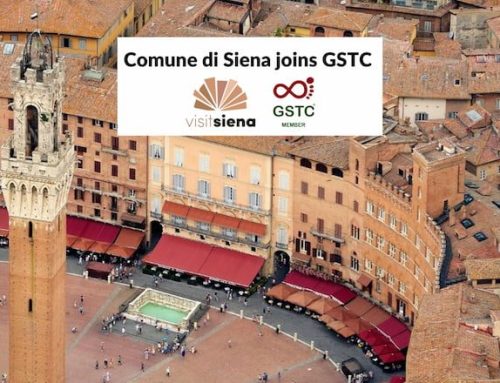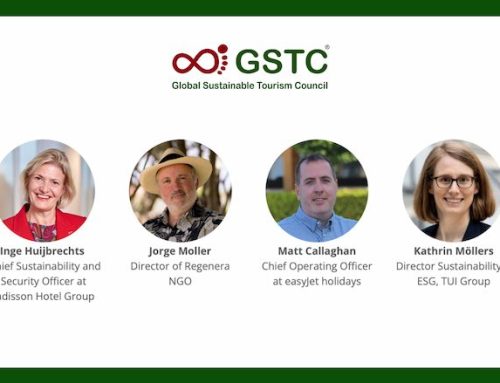Introduction

The Global Sustainable Tourism Council (GSTC), the leading organization on sustainable tourism accreditation, recently released their Destination Criteria 2.0. It provides a common framework for examining destination-level sustainable tourism certification. The GSTC Criteria are organized in four sections: sustainable management, socio-economic sustainability, cultural sustainability, and environmental sustainability. With these 4 sections there are 38 criteria and 174 indicators that destinations may use to assess their progress on achieving the criteria.
A New Perspective
This report (Part 3 of 4) will focus on the:
- Programs and Systems
Tourist destinations are complex systems. In this report, we use the term “destination” without designating a specific actor. It is important to note that we are not implying that either the local Destination Stewardship Organization (A1) or Destination Management Organization (DMO) is the sole responsible party.
Programs and Systems to Ensure Sustainable Tourism Development
Building a Sustainable Tourism “Ecosystem” in the destination [15]
The destination should provide support programs to encourage the adoption of sustainable practices. Examples include programs that:
- Connecting local businesses and fair-trade operations
- Informing, educating and training locals and residents on the importance of sustainable tourism
- Educating visitors on issues relevant to the destination and sustainable solutions
- Measuring and managing visitor volumes, activities, and patterns of tourists
Engagement Programs
A core principle of sustainable tourism development is engagement. Engagement programs should encourage collaboration throughout all stakeholders. The GSTC criteria requires programs that engage with:
- Tourism businesses
- Residents [16]
- Visitors [17]
One of the fundamental components of sustainable tourism is that stakeholders have a role in determining how tourism is developed within the destination community.
Visitor Management Systems [18]
Sustainable tourism developments should include measuring and managing visitors volume and activities. The GSTC requires destinations to limit and spread visitation to balance the needs of the:
- Local economy
- Local community
- Cultural heritage
- Environment
In addition to requiring visitor management in the destination as a whole, the GSTC criteria highlights the need for visitor management at cultural sites and natural sites, as well.
Environmental Programs
Protecting the environment of a destination is a critical element of sustainable tourism management. Sustainable destination communities should provide programs that:
- Protect natural sites and sensitive environments [19]
- Protect biodiversity, reduce species exploitation and encourage animal welfare [20]
- Minimize light and noise pollution [21]
- Encourage the adoption low impact transportation [22]
Environmental Resource Management Programs
Sustainable destination communities should have programs that support sustainable use of natural resources. Such programs include:
- Energy conservation [23]
- Water stewardship and quality [24]
- Waste management programs [25]
- Climate change adaptation and mitigation [26]
Cultural and Heritage Programs
Sustainable destination communities should have programs that recognize the importance of culture and heritage in the destination. These programs include:
- Visitor management at cultural sites that take into account the characteristics of, capacity, and sensitivity of the site and reduces adverse impacts [27]
- Rehabilitation and conservation of cultural assets
- Communication and education of cultural heritage sites, celebration experiences (events, products, etc.)
- Guidelines and behaviors for visitors at heritage sites and events
- Code of conduct and practices for tour operators & guides at heritage sites and events
- Proper training of operators and guides
- Programs supporting the celebration of intangible cultural heritage including local traditions, arts, music, language, gastronomy and other aspects of local identity [28]
Culturally and Environmentally Appropriate Promotion and Information [29]
The effective promotion of a destination is critical in order to gain benefits from sustainable development. Marketing and advertisements released should have accurate information about the destination.
Promotion materials should be developed in consultation with local communities, environmental and cultural bodies to ensure proper content. Marketing messages should treat local communities and natural and cultural assets with respect.
Programs that ensure interpretation at cultural sites informs visitors of the significance of the sites they are visiting and is presented in a culturally appropriate manner.
Decent Work and Career Opportunities – Workforce Development Programs [30]
Destinations must encourage and support career opportunities and training possibilities within their tourism sector for the local community. Employment should include:
- Training and skill courses to enable locals to pursue career opportunities
- Equal opportunity for all including women, young people, minorities and people with disabilities
- Safe and secure working conditions
- Decent and fair living wage
Fair Trade and Local Business Support programs [31]
A core principle of sustainable tourism is retaining the revenue within the local economy. Programs should promote fair trade principles and encourage the following:
- Purchases at local tourism enterprises
- Advice and financial guidance be provided to local tourism enterprises for pricing and marketing
Support for the Community [32]
Destinations should facilitate support for local communities and sustainable initiatives through the local tourism enterprises. This can include encouraging tourism businesses and visitors to support local issues. One example of such programs is reliable volunteer programs through the tourism industry that really benefit the local community.
Risk Management and Crisis Response Program [33]
Risk management and crisis management programs are critical in achieving a sustainable tourism plan. Destinations face a variety of risk factors including natural disasters, terrorism, public health issues, and others unique to their location. Sustainable Destination communities should have programs including the following:
- Identifying and mitigating risks
- Crisis response programs (communication protocols and training for stakeholders, including tourism businesses, locals and visitors)
Safety and Security [34]
The destination will have a program to ensure the safety needs of visitors and residents. This will be done by developing systems that monitor, prevent, publicly report, and respond to any crime, safety and health hazards.
[15] A4: Enterprise engagement and sustainability standards
[16] A5: Resident Engagement and Feedback
[17] A6: Visitor Engagement and Feedback
[18] A8: Managing Visitor Volumes and Activities, C6: Visitor Management at Cultural Sites, D2: Visitor management at natural sites
[19] D1: Protection of the Environment
[20] D4: Species Exploitation and Animal Welfare
[21] D12: Light and Noise Pollution
[22] D11: Low Impact Transport.
[23] D5: Energy Conservation
[24] D6: Water Stewardship, D7: Water Quality, D8: Wastewater
[25] D9: Solid Waste
[26] A10: Climate Change Program
[27] C6: Visitor Management at Cultural Sites
[28] C3: Intangible Heritage
[29] A7: Promotion and Information, C7: Site Interpretation
[30] B2: Decent Work and Career Opportunities
[31] B3: Supporting Local Entrepreneurs and Fair Trade
[32] B4: Support for Community
[33] A11: Risk Management
[34] B7: Safety and Security
The is part 2 of a series of 4 parts:
- Insights from the GSTC Destination Criteria 2.0 – Part 1
- Insights from the GSTC Destination Criteria 2.0 – Part 2
- Insights from the GSTC Destination Criteria 2.0 – Part 3
- Insights from the GSTC Destination Criteria 2.0 – Part 4
Download: pdf file available here
Source: Dr. Jonathon Day & Jennifer Romanchek, School of Hospitality and Tourism Management
Sustainable Tourism and Responsible Travel Lab ( STaRTlab)
Purdue University | College of Health and Human Science
Web adaptation: Valentina Gambino




